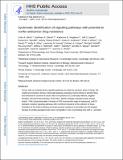| dc.contributor.author | Martz, C. A. | |
| dc.contributor.author | Ottina, Kathleen | |
| dc.contributor.author | Singleton, K. R. | |
| dc.contributor.author | Jasper, J. S. | |
| dc.contributor.author | Wardell, S. E. | |
| dc.contributor.author | Peraza-Penton, A. | |
| dc.contributor.author | Anderson, G. R. | |
| dc.contributor.author | Winter, P. S. | |
| dc.contributor.author | Alley, H. M. | |
| dc.contributor.author | Kwong, L. N. | |
| dc.contributor.author | Cooper, Z. A. | |
| dc.contributor.author | Tetzlaff, M. | |
| dc.contributor.author | Chen, P.-L. | |
| dc.contributor.author | Rathmell, J. C. | |
| dc.contributor.author | Flaherty, K. T. | |
| dc.contributor.author | Wargo, J. A. | |
| dc.contributor.author | McDonnell, D. P. | |
| dc.contributor.author | Wood, K. C. | |
| dc.contributor.author | Wang, Tim | |
| dc.contributor.author | Sabatini, David | |
| dc.date.accessioned | 2015-06-26T15:14:17Z | |
| dc.date.available | 2015-06-26T15:14:17Z | |
| dc.date.issued | 2014-12 | |
| dc.date.submitted | 2014-10 | |
| dc.identifier.issn | 1945-0877 | |
| dc.identifier.issn | 1937-9145 | |
| dc.identifier.uri | http://hdl.handle.net/1721.1/97538 | |
| dc.description.abstract | Cancer cells can activate diverse signaling pathways to evade the cytotoxic action of drugs. We created and screened a library of barcoded pathway-activating mutant complementary DNAs to identify those that enhanced the survival of cancer cells in the presence of 13 clinically relevant, targeted therapies. We found that activation of the RAS-MAPK (mitogen-activated protein kinase), Notch1, PI3K (phosphoinositide 3-kinase)–mTOR (mechanistic target of rapamycin), and ER (estrogen receptor) signaling pathways often conferred resistance to this selection of drugs. Activation of the Notch1 pathway promoted acquired resistance to tamoxifen (an ER-targeted therapy) in serially passaged breast cancer xenografts in mice, and treating mice with a γ-secretase inhibitor to inhibit Notch signaling restored tamoxifen sensitivity. Markers of Notch1 activity in tumor tissue correlated with resistance to tamoxifen in breast cancer patients. Similarly, activation of Notch1 signaling promoted acquired resistance to MAPK inhibitors in BRAF[superscript V600E] melanoma cells in culture, and the abundance of Notch1 pathway markers was increased in tumors from a subset of melanoma patients. Thus, Notch1 signaling may be a therapeutic target in some drug-resistant breast cancers and melanomas. Additionally, multiple resistance pathways were activated in melanoma cell lines with intrinsic resistance to MAPK inhibitors, and simultaneous inhibition of these pathways synergistically induced drug sensitivity. These data illustrate the potential for systematic identification of the signaling pathways controlling drug resistance that could inform clinical strategies and drug development for multiple types of cancer. This approach may also be used to advance clinical options in other disease contexts. | en_US |
| dc.description.sponsorship | National Institutes of Health (U.S.) (Grant CA103866) | en_US |
| dc.description.sponsorship | National Institutes of Health (U.S.) (Grant AI07389) | en_US |
| dc.language.iso | en_US | |
| dc.publisher | American Association for the Advancement of Science (AAAS) | en_US |
| dc.relation.isversionof | http://dx.doi.org/10.1126/scisignal.aaa1877 | en_US |
| dc.rights | Article is made available in accordance with the publisher's policy and may be subject to US copyright law. Please refer to the publisher's site for terms of use. | en_US |
| dc.source | PMC | en_US |
| dc.title | Systematic identification of signaling pathways with potential to confer anticancer drug resistance | en_US |
| dc.type | Article | en_US |
| dc.identifier.citation | Martz, C. A., K. A. Ottina, K. R. Singleton, J. S. Jasper, S. E. Wardell, A. Peraza-Penton, G. R. Anderson, et al. “Systematic Identification of Signaling Pathways with Potential to Confer Anticancer Drug Resistance.” Science Signaling 7, no. 357 (December 23, 2014): ra121–ra121. | en_US |
| dc.contributor.department | Massachusetts Institute of Technology. Department of Biology | en_US |
| dc.contributor.department | Whitehead Institute for Biomedical Research | en_US |
| dc.contributor.mitauthor | Wang, Tim | en_US |
| dc.contributor.mitauthor | Sabatini, David M. | en_US |
| dc.relation.journal | Science Signaling | en_US |
| dc.eprint.version | Author's final manuscript | en_US |
| dc.type.uri | http://purl.org/eprint/type/JournalArticle | en_US |
| eprint.status | http://purl.org/eprint/status/PeerReviewed | en_US |
| dspace.orderedauthors | Martz, C. A.; Ottina, K. A.; Singleton, K. R.; Jasper, J. S.; Wardell, S. E.; Peraza-Penton, A.; Anderson, G. R.; Winter, P. S.; Wang, T.; Alley, H. M.; Kwong, L. N.; Cooper, Z. A.; Tetzlaff, M.; Chen, P.-L.; Rathmell, J. C.; Flaherty, K. T.; Wargo, J. A.; McDonnell, D. P.; Sabatini, D. M.; Wood, K. C. | en_US |
| dc.identifier.orcid | https://orcid.org/0000-0002-4227-5163 | |
| dc.identifier.orcid | https://orcid.org/0000-0002-1446-7256 | |
| mit.license | PUBLISHER_POLICY | en_US |
| mit.metadata.status | Complete | |
